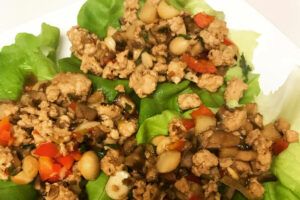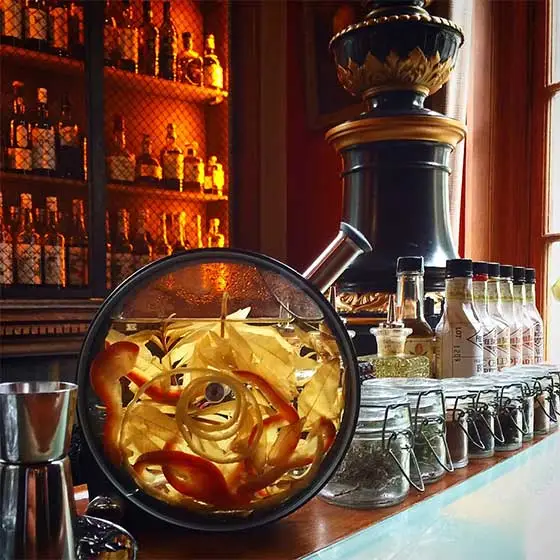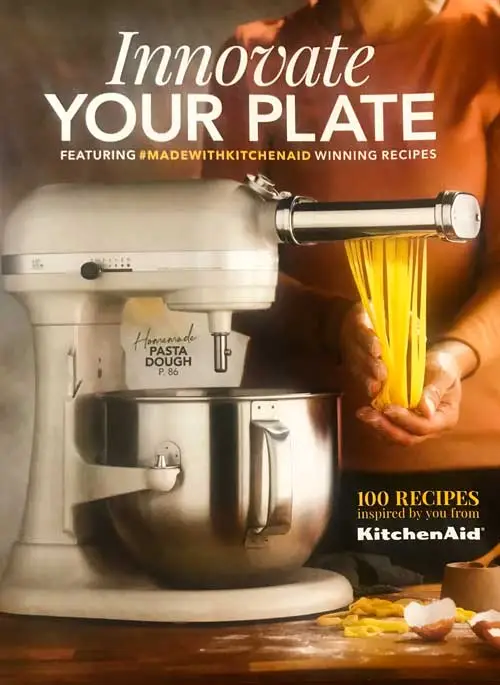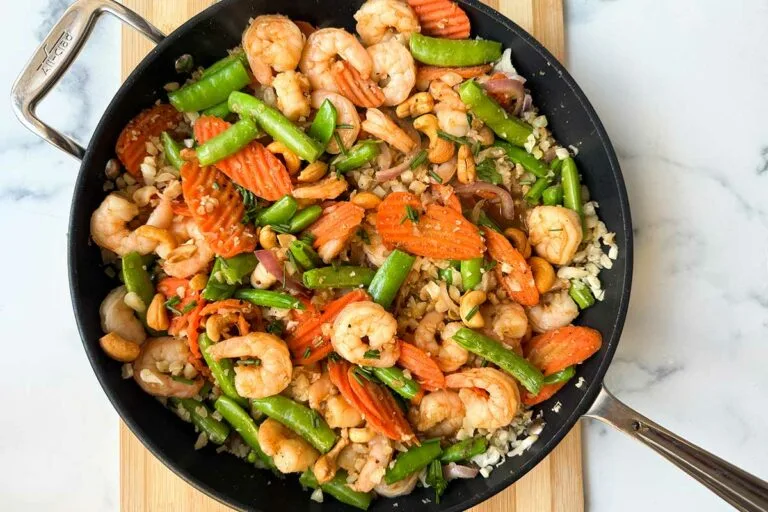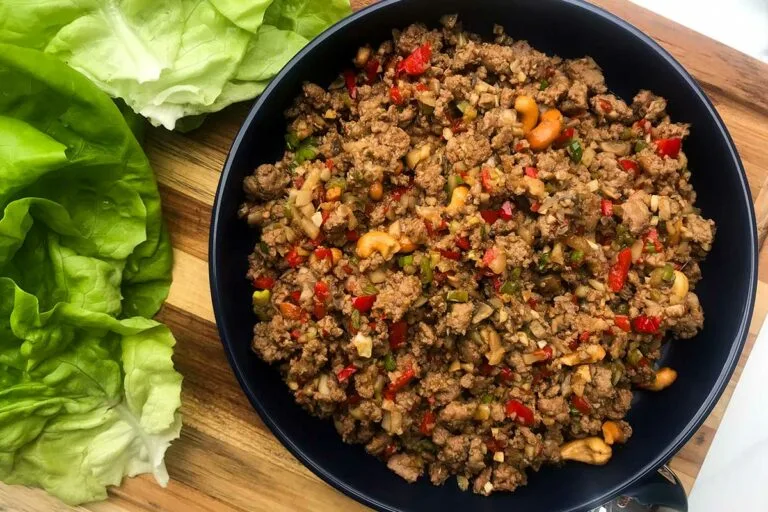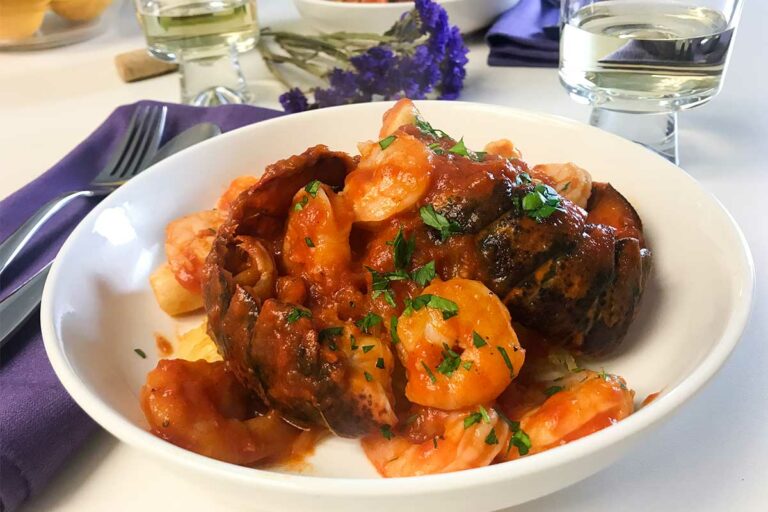
I love, love, love this dish! Spaghetti Squash with Seafood Marinara is my answer to anyone looking for an elegant, upscale dinner easy to make any day of the week, but special enough for those romantic dinners and perfect for company. While I always loved any version of seafood marinara on pasta, substituting spaghetti squash for the pasta made this a low-calorie, low fat, low-carb, high fiber and high protein meal I could have anytime I wanted. Making this dish, changed my idea of what “light and healthy” could actually be.
I didn’t give up any of my favorite shellfish, nor did I give up the sauce (Why would I? It’s light and healthy and down right good for you.) Swapping out the pasta for spaghetti squash, I learned, was more a problem in my head rather than on my palette. I absolutely love it and realized that the sauce and shellfish were what I loved and craved and I didn’t have to give it up.
Let’s talk about ingredients in this dish.
SHELLFISH
In this dish, I use my three favorite shellfish; shrimp, lobster and scallops. I use both sea scallops and bay scallops depending on what I have on hand. Both work and you should use your favorite. If you do use the larger sea scallops, just remember to remove that tough abductor muscle on the side of most sea scallops. They are tough and not pleasant to chew.
While these may be my choices for this recipe, you can easily add, omit or swap the fish of your choice. Mussels, clams and crab would all be amazing. You could also add chunks of a white fish like halibut or cod. Use what you have on hand or what looks good at the fish market.
SAUCE
While I use my own marinara sauce recipe, you can certainly use a good quality store-bought sauce. Rao’s Marinara sauce is a chef’s favorite for a reason. It only has simple, basic ingredients and tastes amazing. But, my sauce is easy to make and you can freeze it and use it as needed. You’ll notice I add a pinch of chili flakes into the sauce. This is optional but I like a little kick to the sauce…not a lot, just enough to elevate the heat a bit.
CHEESE
Putting cheese on shellfish in the Italian culture has always been taboo. However, I like it, so I often grate Parmesan on top. This is completely optional and completely up to you. Don’t let others intimidate you. This is your dinner. Eat it the way you like it!
SPAGHETTI SQUASH
And this is where most of the questions come in. If you haven’t worked with spaghetti squash before or are considering using it more often now that you know it is a great substitute for pasta, these frequently asked questions and answers will help.
Spaghetti squash has a mild and subtly flavor. Its taste is not as strong as traditional pasta, allowing it to pair well with various sauces and seasonings. When cooked properly, it maintains it’s texture and is slightly firm (like pasta) and the flesh can be scraped away with a fork, creating strands that look like spaghetti noodles…hence the name.
Spaghetti squash takes on the flavor of the sauce on it making it the perfect base and substitution for pasta in a lot of dishes like this one. I find I don’t even miss the pasta since it is the sauce and toppings that I am craving.
Here’s how to tell if a spaghetti squash is ripe:
- Color:
- Look for a spaghetti squash with a consistent, deep yellow color. Avoid green areas, as they may indicate that the squash is not fully ripe.
- Firmness:
- Ripe spaghetti squash should feel firm and heavy for its size. Press your fingernail against the skin; it should be tough and not give easily. If the skin feels soft or has noticeable dents, the squash may be overripe or not ripe yet.
- Skin Texture:
- The skin of a ripe spaghetti squash should be hard and not have any soft spots or blemishes. Check for a smooth and unblemished surface.
- Stem:
- Examine the stem where it was attached to the vine. A dry and withered stem is an indication that the spaghetti squash is mature and ready.
- Size and Weight:
- Choose a spaghetti squash that is heavy for its size, as this suggests it is filled with more moisture, contributing to better texture and flavor.
- Sound:
- When you tap the squash with your knuckles, it should produce a hollow sound. This can be an additional indicator of ripeness.
Determining whether a squash is bad involves considering various factors related to its appearance, texture, and smell. Here are some signs that may indicate a squash is no longer good:
Visual Inspection:
- Mold: Check for the presence of mold on the surface. Mold can appear as fuzzy patches or dark spots. If you see mold, it’s best to discard the squash.
- Discoloration: Look for any significant changes in color. While slight variations are normal, an overall change to a dull or off-color may indicate spoilage.
- Soft Spots or Wrinkles: Press gently on the squash. If it feels overly soft or has wrinkles, it may be past its prime.
Texture:
- Mushiness: Squash should generally have a firm texture. If the flesh feels excessively mushy or slimy, it’s a sign of deterioration.
Smell:
- Off Odor: A bad or foul smell is a clear indication that the squash has gone bad. Fresh squash should have a neutral or slightly sweet aroma.
Internal Condition:
- Seeds and Inner Flesh: If you cut the squash open and find that the seeds or inner flesh have a strange or off-putting smell, appearance, or texture, it may be a sign of spoilage.
Water Content:
- Excessive Moisture: If there is an excessive amount of moisture on the squash’s surface or inside the cavity, it could indicate decay or bacterial growth.
I’m always asked how to cut a spaghetti squash. And truthfully, it can be challenging the first time. But, I’ve got some tips to help you get that squash cut. First, make sure you are using a very sharp chef’s knife. Sharpen it. Second, use my microwave tip. I put the whole squash in the microwave for 3-5 minutes to soften it. It makes it easier to cut. Just remember to stab the squash with the tip of a paring knife to let the steam escape when it is in the microwave. That will keep the squash from exploding…and that is a good thing!
Spaghetti squash carbs are minimal especially when compared to pasta. The net carbs in one cup of spaghetti squash is 8 net carbs.
- Total Carbohydrates: Approximately 10 grams
- Dietary Fiber: Roughly 2 grams
- Net Carbs: Total Carbohydrates minus Dietary Fiber
- Net Carbs: 10 grams – 2 grams = 8 grams
If you are on a low carb diet, spaghetti squash is a great choice.
Now, that we’ve reviewed the ingredients in the dish, it’s time to jump in. To get started with this dish preheat the oven to 375 degrees F. Then, let’s prep and cook the squash. Cutting squash can be a tough job. To make it easier, I recommend two things. First, you need a really sharp chef’s knife. Now is the time to sharpen it. Next, to soften up the squash a little bit, I will stab it with the tip of a sharp paring knife all over the squash. Then, I microwave the squash for about 3-5 minutes to soften the squash. Stabbing it before putting in the microwave will keep the squash from exploding in the microwave.
Remove the squash from the microwave and carefully cut it in half lengthwise. Press down on the chef’s knife until you cut all the way through. Be careful. Next, take a large spoon and scrape out the seeds from the middle of the two halves and discard. Using a pastry brush, brush the cut side of the squash with olive oil and sprinkle with salt and pepper. Place the cut side down on a parchment paper lined baking sheet and bake in the oven for 25 minutes. Flip the squash over and roast for another 15 minutes.
One note on roasting the squash: it is sooooo much better when roasted in the oven compared with just “nuking it” in the microwave. I’ve cooked the squash in the microwave but it gets watery and a bit mushy. I find that it totally destroys the texture so I don’t recommend it. I simply use the microwave to soften and assist with the cutting of the squash.
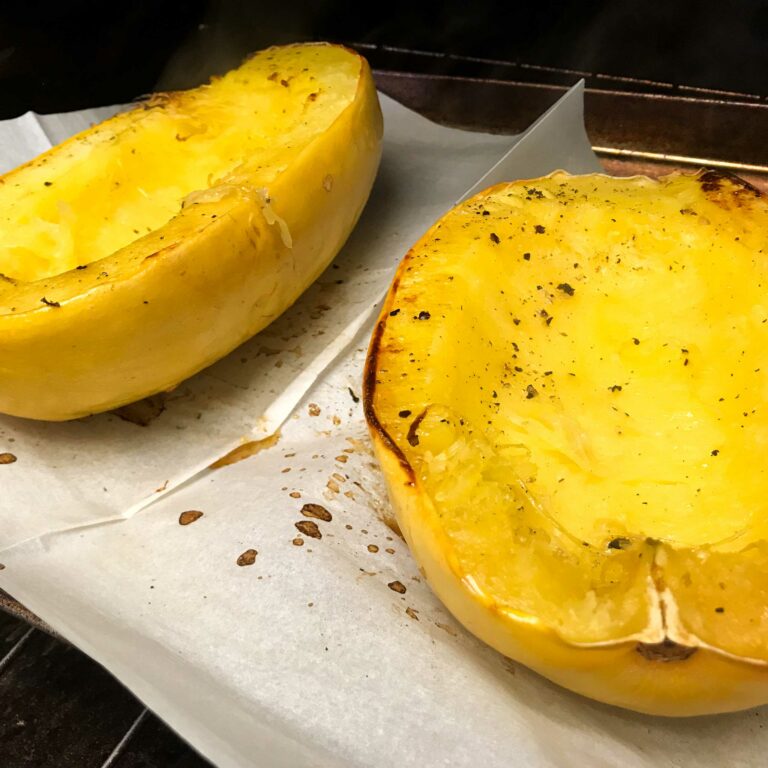
While the squash roasts, make the marinara sauce following the instructions in the recipe. Otherwise, if you have it already made or are using a jarred sauce, pour into a large skillet.
Next, prep your shellfish. I dry my shrimp and scallops with paper towel. Remember, if you are using sea scallops, remove that tough abductor muscle on the side. Sprinkle them with salt and pepper. For the lobster tails, I cut them in half to help cook them faster. You can do this two ways. Use a pair of kitchen scissors and cut down the shell side first, then flip over and cut through the underbelly. Then, using a chef’s knife, completely cut through the lobster tail through the slits you’ve already created. OR, using all your strength (LOL), use a sharp chef’s knife and press down hard, cutting straight through the shell to the cutting board.
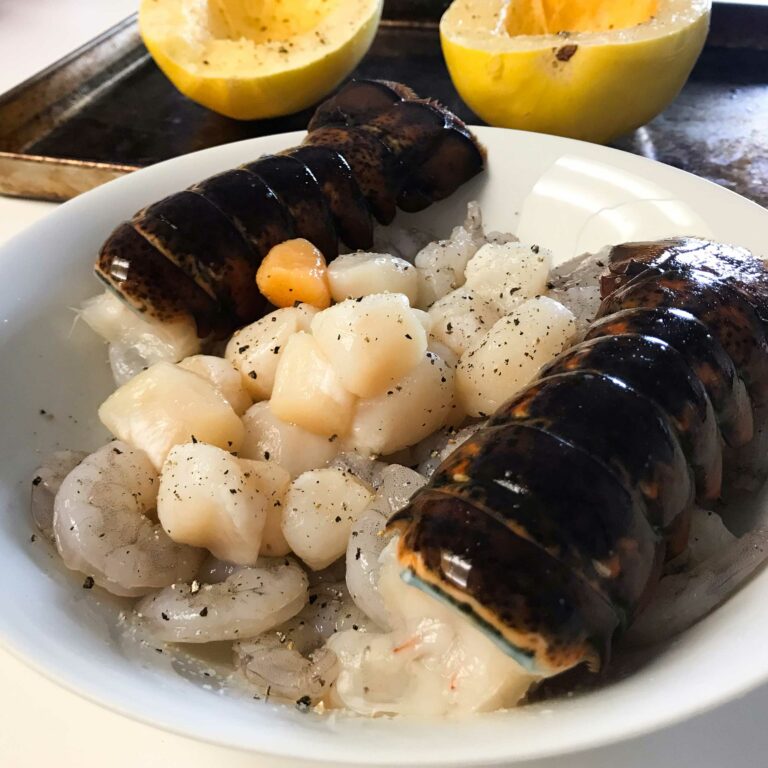
About ten minutes before the squash are done, heat the marinara sauce on the stove over medium heat. Add the pinch of chili flakes (more if you like it spicy) and stir to combine. Nestle the shrimp, scallops and cut lobster tails down into the sauce. Let the sauce come up to a simmer and turn and gently toss the scallops and shrimp so they are cooking on all sides. You’ll know they are cooked because the shrimp will turn pink and slightly curl. The scallops will no longer be translucent and the lobster meat will turn white and they will naturally curl in the pan.
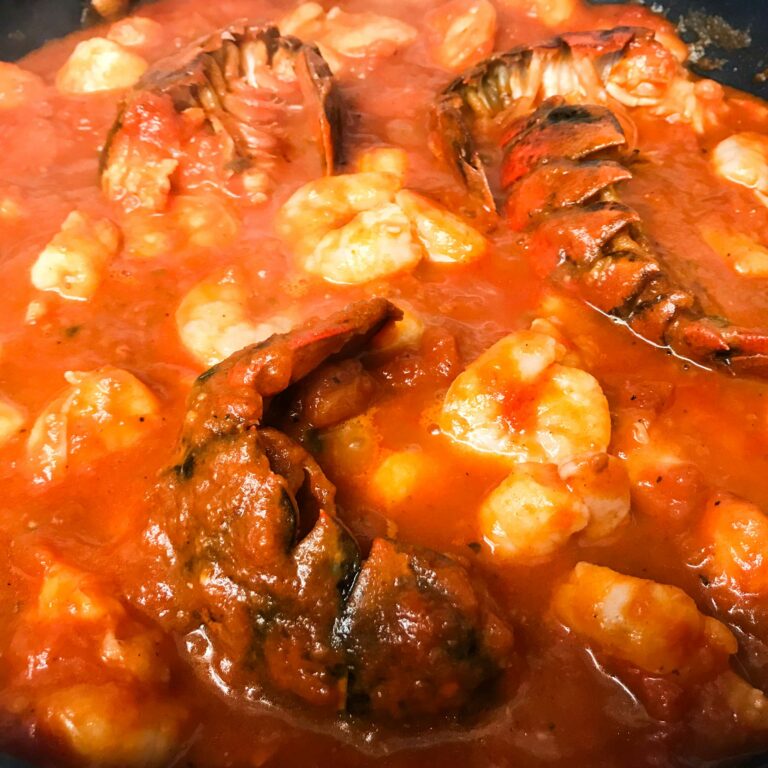
Using a fork, scrape the spaghetti squash creating long strands like spaghetti. Put the squash in a shallow pasta bowl and top with the seafood marinara. If using, sprinkle with Parmesan. Finish with the chopped parsley. Dig in and enjoy.
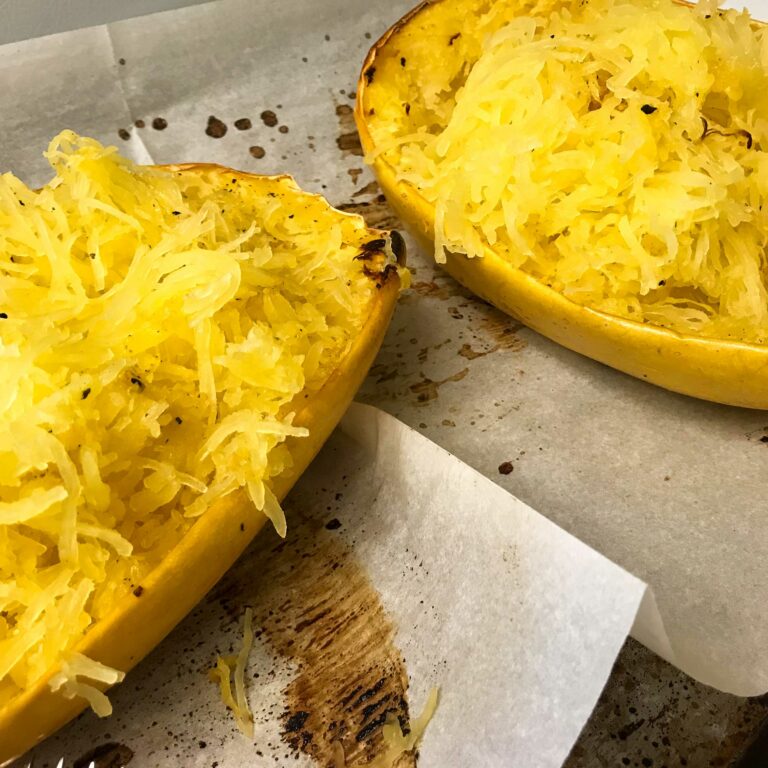
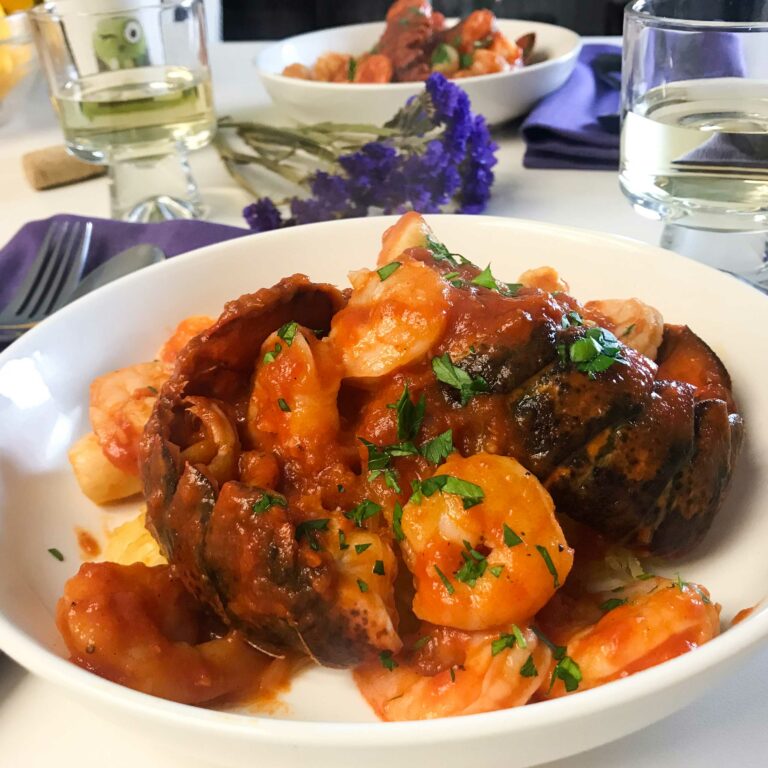
If you like this recipe, but don’t want to give up the pasta, try my New Year’s Seafood Fettuccine.
For other healthy seafood dinner options, check out these recipes:
Mediterranean Shrimp and Tzatziki Pitas
Salmon with Bourbon and Peaches
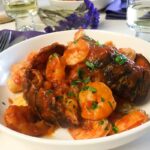
Spaghetti Squash with Seafood Marinara
Nutritional information is only an estimate. The accuracy of the nutritional information for any recipe on this site is not guaranteed.
Ingredients
- 1 Medium Spaghetti Squash
- ½ Lb. Medium Shrimp, deveined and shelled
- ½ Lb. Scallops, sea or bay
- 2 4-6 Oz. Lobster tails, cut in half
- 1 1/2 Cups Marinara Sauce
- ¼ Tsp. Calabrian chili flakes
- 1 Tbsp. Olive oil
- Kosher Salt & Freshly Ground Black Pepper
- Shaved Parmesan Cheese (optional)
- Fresh Italian parsley (optional)
Instructions
SQUASH:
- Cut the squash in half lengthwise. Scoop out the seeds. Brush the squash on both cut sides with olive oil. Sprinkle with salt and pepper. Place cut side down on a foil lined or parchment paper lined baking sheet and roast in a 375-degree F. oven for 25 minutes. Turn the squash over and roast for another 15 minutes. The squash should be soft and browned in spots.
- Remove from oven and using a fork, scrape squash and watch “spaghetti form”. Place on plates or in shallow pasta bowls and top with the seafood sauce.
SAUCE:
- Heat the marinara sauce in a wide skillet on the stove. Add the Calabrian chili flakes as soon as you pour the sauce into the pan. When it starts to bubble, add the shrimp, scallops and lobster tails and simmer until seafood is cooked through (about 10 minutes).
- Spoon the seafood marinara sauce over the spaghetti squash. Top with shaved or grated Parmesan cheese if using. Finish with chopped parsley. Enjoy.

